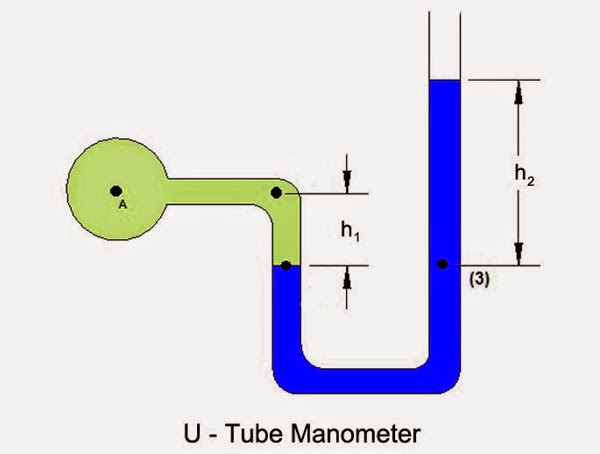What Is a Differential Manometer?
A device which is used to measure difference of pressure between the two fluids which are flowing through the two different pipes or in same pipe at two different points is known as DIFFERENTIAL MANOMETER. Differential manometers can range from devices simple enough to be built at home to complex digital equipment.
TYPES OF DIFFERENTIAL MANOMETERS
There are two types of differential manometer as given below:-
1] U-Tube Differential Manometer
2] Inverted U-Tube Differential Manometer.
U-Tube Differential Manometer
Figure 2.12 : Differential U-tube manometer
Differential U-tube manometer (Fig. 2.12) is very handy to measure the pressure difference directly and is basically similar to the U-tube manometer discussed above. What was the open end before is now connected to a different pressure,
And,
INVERTED U-TUBE DIFFERENTIAL MANOMETER
The inverted U-Tube Differential manometer is reciprocal of U-Tube Differential manometer at the different level. This type of manometers are used to measure accuracy of small difference if pressure is increased.
Figure : Inverted Differential Manometer
Function
Standard manometers are used to measure the pressure in a container by comparing it to normal atmospheric pressure. Differential manometers are also used to compare the pressure of two different containers. They reveal both which container has greater pressure and how large the difference between the two is.
Use
Differential manometers have a wide range of uses in different disciplines. One example is that they can be used to measure the flow dynamics of a gas by comparing the pressure at different points in the pipe.
Construction
The simplest differential manometer is a U-shaped tube with both ends at the same height. A liquid, usually water or mercury, rests at the bottom of the tube.
Working
If one end of the tube is in a place with higher air pressure, the pressure will push down the liquid on that side of the tube. By measuring the difference between the heights of liquid, it is possible to calculate the difference in pressure.
Calculation
To calculate the difference in pressure, multiply the difference in height by the density of the gas and the acceleration due to gravity. The final units should be in pascals.

